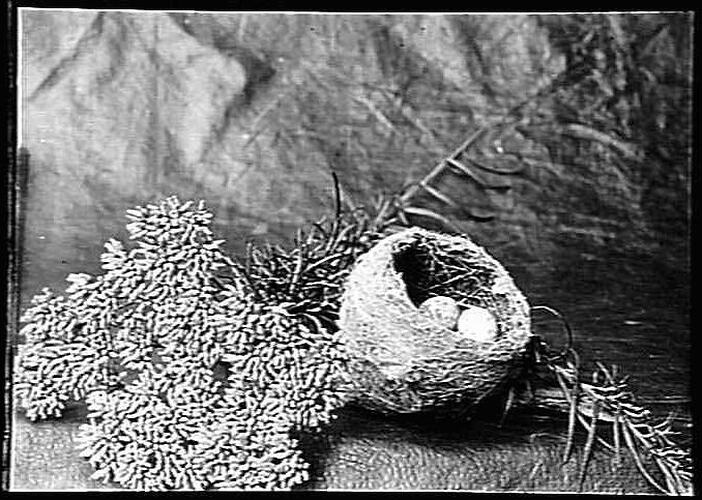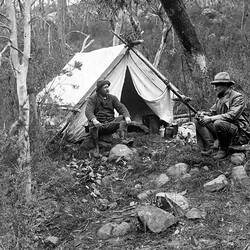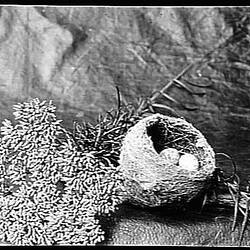WHITE-SHAVED FANTAIL (Rhipdura albiscapa, Gould - 134)
Geographical Distribution - Queensland, New South Wales, Victoria and South Australia.
Nest - Neatly and marvellously made, wine-glass shaped, with the base of the stalk broken off, composed of fine dry grass, but more usually of shreds of fine bark, matted exteriorly with spiders' web, imparting to the nest a greyish appearance; lined inside with soft grass, and sometimes fine, yellowish rootlets, with one or two horse-hairs added, and usually situated a few feet from the ground in warm scrub, where the nest is saddled on a naked horizontal twig (with the tail-like appendage extended underneath the twig upon which the nest is built) of a small sapling or bush, or more frequently on a branchlet overhanging a stream. Dimensions over all, 2-1/2 inches by 1-3/4 inches depth; not including the tai like appendage, 1 to 1-1/2 inches long; egg cavity, 1-1/2 inches across by 1-1/8 inches deep. (See illustration.)
Eggs - Clutch, two or three; short oval in shape, prominently rounded at top end; texture of shell very fine; surface slightly glossy; colour ,light yellowish-white, mottled and spotted, particularly about the upper quarter, with light-umber or rufous and dull-grey. Dimensions in inches of a proper clutch: (1) .67 X .48, (2) .65 X .49, (3) .6 X .45. (Plate 8)
Observations - Generally described, this bird has the whole of its upper surface dark-grey; moon or crescent-shaped markings over the eyes and behind the ears, throat, tips of the wing coverts, margin of the secondaries white. Shafts of the tail feathers are also white (hence the vernacular name, White-shafted Fantail); under surface buff; eyes, bill, and feet black; total length, 6-1/2 inches (including tail, 3-3/4 inches.
This exceedingly tame and lively little favourite is distributed over most of the eastern part of Australia, where it is everywhere met, especially in the more heavily-forested parts. The White-shafted Fantail has closely-allied representatives in Northern Australia, Western Australia, and Tasmania; therefore it is again advised that the study of their respective habitats will greatly aid the zoologist in separating the different species.
Quite a chapter might be written on this interesting and useful little Fantail and its beautifully-built, small elegant nest - sometimes not much bigger than the bowl of a large smoking pipe - which always attracts attention, particularly the singular ornamental handle or tail that is prolonged downward from the body of the nest.
When I meditate on those wonderfully-made little nests I always think of the lines, 'A Bird's Nest,' which I learned at school:-
It wins my admiration
To view the structure of that little work -
A Bird's nest. Mark it well within, without;
No tool had he that wrought; no knife to cut;
No nail to fix; no bodkin to insert;
No glue to join; his little beak was all;
And yet how nicely finished! What nice hand,
With every implement and means of art,
And twenty years' apprenticeship to boot,
Could make one such another?
-Hurdis.
There are various suggestions about the utility of this tail, which is constructed long or short according to the whim of the bird. If not for ornamental purposes, I believe it is a case of pure mimicry, in which the nest and tail are made to represent an excrescence on the twig, the bird sometimes having to build its nest in exposed situations where food is plentiful; but whether it be essential for the stability of the nest or the safety of its contents, the tail always takes shape early in the construction of the nest. Although the nest proper is perfect for symmetry and neatness, the termination of the tail is frequently slovenly finished off, merely a few shreds of bark hanging by spiders' webs, which any breeze might unravel. The late Mr. T.H. Potts, who gave considerable attention to the Flycatcher of this genus inhabiting New Zealand, believed the affixing of the appendage steadied the nest in exposed yet good positions for a food supply for the young. It is probably in some situations exposed to sudden draughts or gusts of wind , which, agitating the twig, might endanger the safety of the eggs. Mr. Potts asks, 'Would not the resistance offered by this peculiar addition (the tail) lessen any such danger by diminishing the extent of the vibration?'
I have taken the pretty homes of the White-shafted Fantail from a variety of romantic situations. The first I ever found was overhanging a clear purling stream that had carved for itself a narrow track through a rich alluvial flat, where tall timber grew. The nest was low down, well under the shelter of one of the banks. In the Big Scrub of New South Wales I took another beautiful nest for two purposes, firstly, to enrich my collection from that locality, and secondly because it stood right in the way between my camera lens and a picturesque waterfall I intended to photograph.
Mr. Lau writes, of the White-shafted Fantail:- 'This happy little bird may be seen all over the Downs of Queensland, in the open forest as well as in the scrub; but to look for its nest you have to resort to the latter place. In the month of October you may find a receptacle - a most lovely production - the property of this Flycatcher, sometimes within reach, although oft-times ten to twenty feet high in a tree. This nest is exactly the shape of a wine-glass without the foot, manufactured out of fine dry grass connected or enclosed by spiders' web, and lined throughout with fibres or fine rootlets. A nest containing two roundish eggs was taken at Cunningham's Gap, in the Toowoomba Range,1876. The first nest I found, however, was in 1856, at Ullandulla, New South Wales.'
With regard to R. flabellifera of New Zealand, a closely-allied form to the R. albiscapa, the following periods of time noted by Mr. Potts respecting its nidification may apply to the Australian bird, and therefore not be out of place:-
On the 23rd October he found a nest with only the foundation laid. The pair of birds building had a brood of three young ones to feed, hatched from another nest not far away. 27th.- Nest apparently finished and contained one egg. 29th.- Three eggs. 14th November.- Four young hatched. 27th - Young birds quitted their home.
Sometimes the White-shafted Fantail will pull down a partly-constructed nest and built it elsewhere for no other reason apparently then its having been seen or watched b y some person. This little bird seems to be a favourite foster-parent of the Square-tailed Cuckoo (C. variolosus). The White-shafted Fantail is a late breeder. I have never taken eggs earlier than the 13th October, and have taken them as late as Christmas time. Between these periods probably two or more broods are reared.
Resources
Transcribed Archibald James Campbell. Nests and Eggs of Australian Birds, including the Geographical Distribution of the Species and Popular Observations Thereon, Pawson & Brailsford, Sheffield, England, 1900, pp. 108-110.
More Information
-
Keywords
-
Authors
-
Contributors
-
Article types


